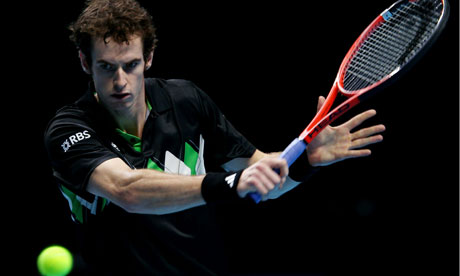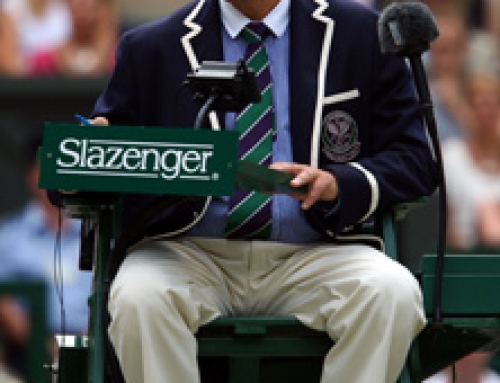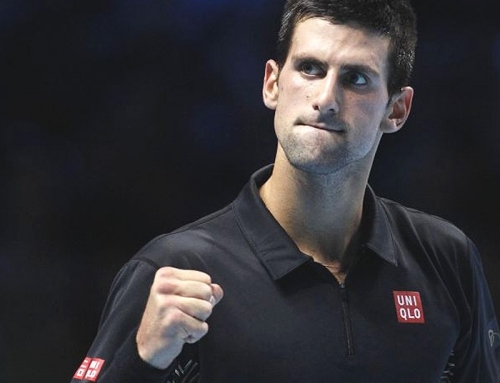 Andy Murray, the only player in the field from Britain, knew the drill. Decked out in an argyle outfit that recalled the early years of Ivan Lendl, but using black as the background instead of white, Murray was a man on a mission.
Andy Murray, the only player in the field from Britain, knew the drill. Decked out in an argyle outfit that recalled the early years of Ivan Lendl, but using black as the background instead of white, Murray was a man on a mission.
Last year, he, Roger Federer, Juan Martin del Potro and Fernando Verdasco were in Group A while Nadal, Djokovic, Davydenko, and Soderling were in Group B.
Each group had it’s 0-3 player meaning, against the other 3 opponents in the group, they had won zero matches. In Group A, that player was Fernando Verdasco. In Group B, shockingly enough, it was Rafael Nadal.
Although Verdasco did not win a single match, he ended up playing a pivotal role in determining which 2 players would advance from Group A.
Here’s how it worked. Each of the 12 matches played in Group A went the distance. Although Verdasco did not win a match, he won a set off each of his 3 opponents.
Of the 3 remaining players, each had lost a match. Federer lost a match to Juan Martin del Potro. del Potro lost a match to Andy Murray. Murray had lost a match to Roger Federer.
The first tiebreak to decide who makes the semis is win-loss record. Federer, del Potro, and Murray had each won 2 matches and lost 1 match. This put everyone equal. The second tiebreak is number of sets won and lost. However, each player had won 5 sets (2 from the matches they won and 1 from the match they lost) and lost 4 sets (1 each from the two matches they won, and 2 sets from the match they lost).
The third tiebreak pivoted on the total number of games won. It’s here that Andy Murray may have wished he had won 2 more games from Federer, or not had Verdasco take him to a third set tiebreak. When all was said and done, del Potro had won 45 total games to 43 lost while Andy Murray had won 44 games–one fewer than del Potro–to 43 lost. The difference was one slender game.
When del Potro beat Federer, Murray asked del Potro if he had made it to the semis. Delpo had no idea. He knew it was close, but hadn’t pulled out a calculator to see if he made it or not.
Murray came into his match against Robin Soderling wanting to make a statement and lose as few games as possible. Between the two of them, they had won the two Masters 1000 titles after the US Open. Murray won his in Shanghai. Soderling won his in Paris. Murray’s win was the tougher one as he beat Roger Federer in the final. Soderling’s key win was Andy Roddick, so it wasn’t quite the same. Though he almost lost to Llodra, it was Llodra who faced tougher opponents including wins over Djokovic and Davydenko.
Even so, since Soderling won so recently, everyone figured he was in good form and he would give Andy Murray trouble. Apparently not. Compared to last year, Murray’s been more likely to drive his backhand, and slice it far less frequently. He’s traded in his trick change-of-pace for a more straightforward hitting style.
It’s not that Murray has completely abandoned his bag of tricks, but that they’ve changed some this year. Soderling is a tough customer because he hits so hard. But he can be a touch predictable. If you hit a mid-crosscourt shot to his forehand, he is likely to run around it and hit an inside-in forehand up-the-line. Murray would anticipate this shot and hit a sharp short crosscourt shot and catch Soderling out of position. When Soderling came to net, Murray would invariably pass him.
And when Murray threw in a few slices, Soderling would mishit some of those. In the end, Murray had twice as many winners as errors and Soderling had twice as many errors as winners. Murray won 6-2, 6-4.
After the win, the ATP decided to celebrate Carlos Moya’s retirements. They showed some videos of his past matches, and they had a group of players, most notably, Rafael Nadal, stand to congratulate him. Moya had been Nadal’s role model growing up since they were from the same part of Spain.
Roger Federer has been in the ATP World Tour Finals so many times, he knew the drill too. David Ferrer is the “weak” guy in Group B. He’s lost to Federer plenty of times. It may be as much mental as it is Federer’s game. Federer dominated the first set, 6-1, and then hung tough to win the second, 6-4. Federer seems to be looking steadier, part of the reason he’s played reasonably well since the US Open (compared to previous years).
This means, with only a pair of matches played, Federer leads Group B by a single game.
Tomorrow’s matches pit Novak Djokovic against Tomas Berdych. Honestly, Berdych has played awful since Wimbledon. He has not come close to giving a good performance since the US Open, and I expect Novak Djokovic, who has been playing well, to win handily.
The other match is more of a toss-up. The one thing I favor is Nadal with rest. After the US Open, the ATP World Tour Finals is the last hurdle Nadal has yet to leap. Nadal decided to skip Paris, ostensibly because of injury, but possibly because the Paris surface is currently the fastest on tour and because he wanted to be well-prepared to win in London. However, Roddick did win against Nadal back in Miami taking an aggressive posture to beat the Mallorcan.
However, two things have changed since then. By the time Nadal had lost in Miami, he had not won a title dating back to Rome, nearly a year earlier. He had lost to Soderling, to del Potro, to Murray, to Djokovic, to Federer, to Davydenko, to Ljubicic. I mean, lots of players. His winning confidence was rather low. He instantly turned it around in Monte Carlo and not only won there, at Rome, and at Madrid, but also the French, Wimbledon, and the US Open.
Second, Roddick was playing at his peak right around Indian Wells and Miami. Sure, he benefited from Roger Federer playing poorly at that time of the year, but even so, he took advantage.
Alas, more recently, Roddick was injured once again, and only in the last few weeks has he started to play better once again. The good news for Roddick is that he’s starting to regain a little form. He’ll have to hope that Nadal is still match rusty and is making errors. This tends to happen when Nadal is off the tour a while. Nadal has claimed the ATP World Tour Finals is tougher than a Slam because you meet only top players throughout the tournament.
So I think Nadal should win this, something like 6-4, 7-6. It kinda depends how Roddick serves and also how Nadal serves, not that Nadal particularly needs his serve to work well to win.



![[WTF] Djokovic wins third year-end title with straight set win over Nadal](https://www.essentialtennis.com/wp-content/uploads/2013/11/20131111nole-500x383.jpg)
![[WTF] Djokovic defeats Federer in round robin play](https://www.essentialtennis.com/wp-content/uploads/2013/11/20131105djo-500x383.jpg)


![[World Tour Finals, Semis] Djokovic and Federer to meet in the finals](https://www.essentialtennis.com/wp-content/uploads/2012/11/20121110fed-500x383.jpg)